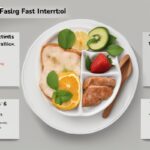Hey there, health enthusiasts! If you’ve been exploring ways to improve your wellness, lose weight, or simply feel more energized, you’ve likely stumbled across the term 16/8 intermittent fasting. This popular fasting method has taken the health world by storm, and for good reason. It’s not just another fad diet; it’s a sustainable lifestyle tweak that aligns with your body’s natural rhythms. In this deep dive, we’ll unpack what 16/8 intermittent fasting is, how it works, its science-backed benefits, and how you can make it a seamless part of your routine. Whether you’re a beginner or a seasoned faster, stick around—I’ve got practical tips and insights to help you succeed.
What Is 16/8 Intermittent Fasting?
At its core, 16/8 intermittent fasting is a time-restricted eating pattern. The “16/8” refers to the split between fasting and eating windows: you fast for 16 hours and eat during an 8-hour window each day. For example, you might eat between noon and 8 p.m., then fast from 8 p.m. until noon the next day. Unlike traditional diets that focus on what you eat, this method is all about when you eat. It’s incredibly flexible, which is why so many people love it—you don’t have to count calories or cut out entire food groups. The goal is to give your body a break from constant digestion, allowing it to tap into stored energy and potentially improve metabolic health (Varady et al., 2018).
The Science Behind 16/8 Intermittent Fasting
So, why does timing your meals matter? When you fast for 16 hours, your body undergoes several physiological changes. After about 12 hours without food, your glycogen stores (the body’s quick-access energy) start to deplete, and your system shifts to burning fat for fuel—a process called ketosis. This metabolic switch is one reason why 16/8 fasting is linked to weight loss (Anton et al., 2018). Additionally, fasting triggers autophagy, a cellular cleanup process where your body recycles damaged cells, which may support longevity and reduce inflammation (Mattson et al., 2017). Studies also suggest that intermittent fasting can improve insulin sensitivity, helping to regulate blood sugar levels—a big win for preventing type 2 diabetes (Horne et al., 2020).
Beyond the metabolic perks, fasting impacts hormones like ghrelin (the hunger hormone) and leptin (the satiety hormone), potentially reducing appetite over time. While the research is promising, it’s worth noting that results can vary based on individual factors like age, activity level, and overall diet. Still, the growing body of evidence makes a strong case for giving 16/8 intermittent fasting a try under the right guidance.
Key Benefits of 16/8 Intermittent Fasting
The buzz around 16/8 fasting isn’t just hype—it’s backed by some impressive potential benefits. Let’s break down why so many people are raving about this approach to health and wellness.
- Weight Loss and Fat Burning: By limiting your eating window, you’re likely to consume fewer calories naturally. Plus, the metabolic shift to fat-burning during fasting hours can help shed stubborn pounds (Tinsley & La Bounty, 2015).
- Improved Metabolic Health: Fasting has been shown to lower insulin resistance, which can reduce the risk of chronic conditions like diabetes (Horne et al., 2020).
- Enhanced Mental Clarity: Many fasters report feeling more focused during fasting hours, possibly due to stabilized blood sugar and reduced brain fog.
- Simplicity and Flexibility: Unlike restrictive diets, 16/8 doesn’t require meticulous meal planning or eliminating foods, making it easier to stick with long-term.
Potential Challenges and How to Overcome Them
Let’s be real—starting 16/8 intermittent fasting isn’t always a walk in the park. While the method is straightforward, your body might need time to adjust. Common hurdles include hunger pangs, irritability, and social eating pressures. The good news? These challenges are manageable with a little planning. For instance, hunger often subsides after the first week as your body adapts to the new eating schedule. Staying hydrated and sipping on black coffee or tea during fasting hours can also help curb cravings. If social events fall outside your eating window, don’t stress—flexibility is key. You can shift your window occasionally or focus on non-food aspects of gatherings, like conversation and connection.
Practical Tips to Start 16/8 Intermittent Fasting
Ready to dive into 16/8 fasting? I’ve got you covered with actionable steps to ease into this lifestyle. The key is to start slow and listen to your body. Here are some tried-and-true tips to set yourself up for success:
- Choose a Sustainable Eating Window: Pick an 8-hour window that fits your daily routine. If you’re a night owl, a 2 p.m. to 10 p.m. window might work best. Early risers might prefer 10 a.m. to 6 p.m.
- Stay Hydrated: Drink plenty of water during fasting hours to stay energized and reduce hunger. Herbal teas and black coffee (no sugar or cream) are also fair game.
- Focus on Nutrient-Dense Meals: During your eating window, prioritize whole foods like lean proteins, vegetables, and healthy fats to keep you full and fueled.
- Ease In Gradually: If 16 hours feels daunting, start with a 12/12 split (12 hours fasting, 12 hours eating) and work your way up over a week or two.
- Track Your Progress: Use a journal or app to log how you feel, noting energy levels, hunger, and any changes in weight or mood to stay motivated.
Remember, consistency beats perfection. If you slip up or miss a fasting window, don’t beat yourself up—just get back on track the next day. This isn’t about restriction; it’s about creating a rhythm that works for you.
Who Should (and Shouldn’t) Try 16/8 Intermittent Fasting?
While 16/8 intermittent fasting can be a game-changer for many, it’s not a one-size-fits-all solution. It’s generally safe for healthy adults, especially those looking to manage weight or boost energy. However, certain groups should approach fasting with caution or avoid it altogether. Pregnant or breastfeeding women, individuals with a history of eating disorders, and those with medical conditions like diabetes or low blood pressure should consult a healthcare provider before starting (Grajower & Horne, 2019). Fasting can also be tricky if you’re on medications that require food intake at specific times. Always prioritize your health and get personalized advice if you’re unsure whether this method suits you.
In wrapping up, 16/8 intermittent fasting offers a refreshing approach to health that’s less about deprivation and more about timing. With potential benefits like weight loss, better metabolic health, and mental clarity, it’s no wonder this method has gained a loyal following. By starting slow, staying hydrated, and focusing on balanced meals, you can make 16/8 fasting a sustainable part of your life. As with any lifestyle change, listen to your body and consult a professional if you have concerns. So, are you ready to give it a shot? I’d love to hear how it goes for you—drop your thoughts or questions below. Here’s to finding your healthiest, happiest self!
References
- Anton, S. D., Moehl, K., Donahoo, W. T., Marosi, K., Lee, S. A., Mainous, A. G., … & Mattson, M. P. (2018). Flipping the metabolic switch: Understanding and applying the health benefits of fasting. Obesity, 26(2), 254-268. https://doi.org/10.1002/oby.22065
- Grajower, M. M., & Horne, B. D. (2019). Clinical management of intermittent fasting in patients with diabetes mellitus. Nutrients, 11(4), 873. https://doi.org/10.3390/nu11040873
- Horne, B. D., Grajower, M. M., & Anderson, J. L. (2020). Limited evidence for the health effects and safety of intermittent fasting among patients with type 2 diabetes. JAMA, 324(4), 341-342. https://doi.org/10.1001/jama.2020.3908
- Mattson, M. P., Longo, V. D., & Harvie, M. (2017). Impact of intermittent fasting on health and disease processes. Ageing Research Reviews, 39, 46-58. https://doi.org/10.1016/j.arr.2016.10.005
- Tinsley, G. M., & La Bounty, P. M. (2015). Effects of intermittent fasting on body composition and clinical health markers in humans. Nutrition Reviews, 73(10), 661-674. https://doi.org/10.1093/nutrit/nuv041
- Annual Review of Nutrition, 41, 333-361. https://doi.org/10.1146/annurev-nutr-052020-041327






